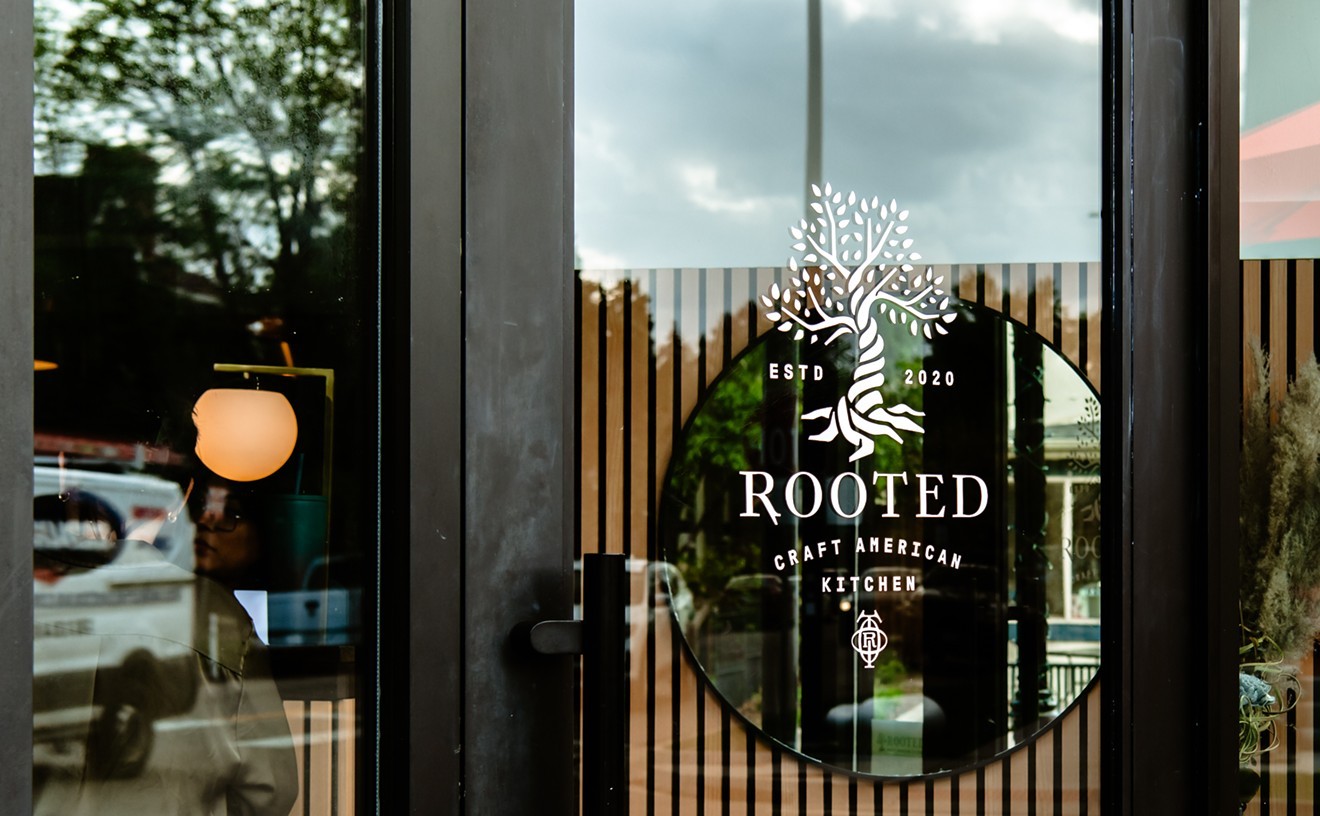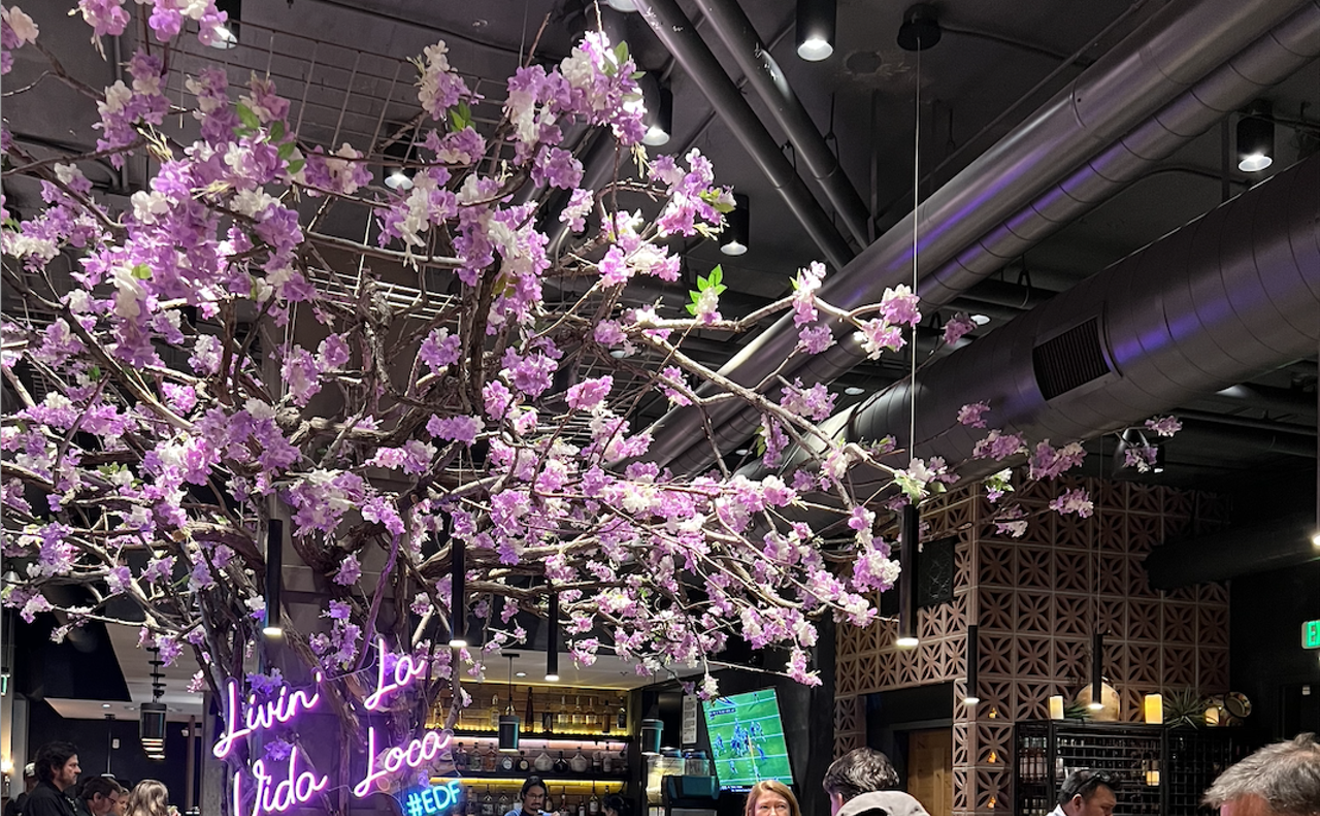This is not the case in Seattle or Fargo or Little Rock or Camden. In those cities, foodies must curse and gnash their teeth at their misfortune to live in a place where the nearest real taco is hundreds, sometimes thousands, of miles away. Women swoon at the mere mention of a stuffed Baja-style fish burrito. Strong men weep openly when they discover a jar of bottled chile verde on the shelf at the local Piggly Wiggly. Across the country, there are entire towns with nothing closer to a Mexican restaurant than the local Taco Bell, where pimply-faced teenagers in paper hats fill mealy tortilla shells with machine-extruded beef by-products -- and the people are thankful.
Sounds crazy, but it's true. I've been there. I've seen these poor bastards line up for the stuff and then come back looking for more. I can't conceive of a life lived without green chile and good flan, but these sad souls don't even know what they're missing. Back East, when you want to find Mexican food in a region where it's as rare as decent Italian is here, the first thing you do when you walk into a place is look for bullfighting posters -- the more the better. Then you look at the customers: Are Mexican families eating there? Finally, you listen to the employees. If they're speaking Spanish, you're in luck. English, you're in trouble. Laotian, Hindi or Greek? Run, don't walk, for the door.
In Denver, identifying the good spots is trickier, because every Mexican restaurant (and most of the American restaurants, French restaurants, pizza places and spaghetti shacks) is staffed by those immigrants and children of immigrants without whom the entire industry would collapse. Nor are the customers a dependable indicator, because Denverites have been steeped since birth in the tradition of eating great Mexican food, so seeing a gaggle of investment bankers and soccer moms sunk to their wrists in pico de gallo is no reason to dismiss a place out of hand. Still, odds are you won't go wrong here: Like pizza joints in the Bronx, cheesesteak places in Philly or barbecue pits in the Carolinas, better-than-average Mexican restaurants abound in Denver. In some neighborhoods, you can't chuck a tamal without hitting one.
But if the one you hit is Tosh's Hacienda, from one tamal-eating, chile-sucking, midnight burrito fanatic to another, take my advice: Skip it. Were Tosh's located anywhere in the country outside of the American Southwest (of which Denver, specifically 64th Avenue, is the absolute northern border), it would be celebrated with parades, immortalized in song and packed to the rafters every night. But here, where we're blessed with great Mexican restaurants, Tosh's just doesn't cut it.
This was not always the case. There was a time when Tosh's was it -- the be-all and end-all of Mexican joints in Denver. Trouble is, that time was decades ago.
Founded in the '40s by the Mackintosh family, La Hacienda -- the name of the original operation -- began as a simple back-porch tamal concession. Yes, a Scottish family making their nickels rolling tamales sounds a lot like a cat working as an astrophysicist, but there's quite a back-story here. The Mackintosh clan were early immigrants to Old Mexico, where they put down roots as ranchers. And they did well, if legend is to be believed, right up until the Mexican Revolution, when Grandpappy Mackintosh was shot down by Zapatistas trying to drive the foreign devils and hacendados out of their ancestral whatever.
It worked, at least as far as the Mackintoshes were concerned. Salvador, one of the Mackintosh sons, fled north across the border into Texas and eventually landed in Denver, where he got a job boning ham for Armour Meats. The meatpacking job ended when Salvador got into a scrap with his boss. He entered into a tamal venture with the Gonzales family -- locals with a name more suited to Mexican food -- but bailed out less than a year later after another dust-up. Finally, he and his family -- wife Esther and seven children -- got into the restaurant business on their own. Already two generations removed from the haggis and shortbread of his forebears, Salvador started La Hacienda, a takeout tamal enterprise that operated out of the Mackintosh home. From takeout in the kitchen to sit-down service in the front room, the business kept growing, and when the demand for Mackintosh tamales became overwhelming, the family hastily constructed a building on the front lawn of their home on Downing Street. This served as La Hacienda's base of operations until 1956, when Salvador sold it and moved operations down the street to an old church.
It was at this point that son Ruben Mackintosh and four of his brothers decided to expand the family business. In addition to the full-scale restaurant at 3090 Downing, they opened carry-out tamal shacks all over the city, tried to get into the chile-canning business, tried selling tortillas and tortilla chips wholesale, until finally -- hugely over-extended, in massive debt and argumentative to a fault (just like their father) -- the brothers ended their partnership in the late '70s. Ruben closed everything except the flagship restaurant, which soon got an economic boost from the Mayor's Office of Economic Development that allowed La Hacienda to update and double in size. La Hacienda became Tosh's Hacienda (Mackintosh, get it?), money started coming in, tables started filling up, and Ruben (along with four of his kids and their spouses) went on to open a second location in the Denver Tech Center and a third in Tubac, Arizona. Then the light-rail station opened at Downing, and the future looked nothing but bright.
So that's how -- at one time -- La Hacienda offered probably the best Mexican food cooked anywhere by descendants of a Scottish war orphan, and how a family named Mackintosh came to be identified with Denver's best tamales. But that time's gone. Today -- with Mexican food everywhere in town, done high-end, low-end and in between; with the economy in the tank and fierce competition for every dollar -- Tosh's has exactly three things going for it. One, longevity. Sixty years builds a lot of name recognition, and since Ruben started pressing tortillas when he was ten years old, there's probably nothing he hasn't seen, no wrinkle in the business that could possibly surprise him. Two, Tosh's has a big smoking section -- fully half of the dining-room floor space is given over to a bar/smoking area well-appointed with TVs, a pot-bellied fireplace in one corner and a handy outdoor patio. The section has plenty of tables, and there's rarely a wait for a seat. And three, Tosh's makes excellent strawberry lemonade. Handmade from squashed lemons and mulled strawberries, it's served over crushed ice in a big Mason jar and tastes like a liquid SweeTart. Of all the things on the menu -- forgettable food and unremarkable drinks included -- the strawberry lemonade is the only one I'd come back for. Even at $3.79 a pop.
Beyond that? Nada m´s que recomendar. The borderlands-style shrimp cocktail was an acidic, cilantro-heavy mess of chopped tomatoes, onions and jalapeños swimming in a decent chilled tomato broth that went great with straight Herradura, but not so well with the browning slices of avocado floating on top of the balloon snifter or the scrawny, tail-on shrimp cowering in the bottom. The chicken mole was made with peanut butter for reasons that defy all culinary logic -- unless there's some kind of ancient Mexi-Gaelic peanut-butter fusion tradition of which I'm unaware. The combination was discordant, making the rolled chicken enchiladas with crushed peanuts taste vaguely Vietnamese at best, and like spicy chicken covered with melted Reese's peanut-butter cups at worst.
The seafood-stuffed sopaipillas were a nightmare -- risen dough gone pasty and wet under a slathering of good (but not great) green chile, stuffed with a big portion of cheap, small, lukewarm shrimp and baby scallops that came dangerously close to having turned. They had that powerfully funky canned-shellfish taste and smelled like the aquarium section of a failing pet store; it took a whole jar of strawberry lemonade and two bowls of Froot Loops when I got home to wash the murk off my tongue. One more day in the coolers or knocking around the back of someone's lowboy, and these crustaceans would've been able to stage their own anti-gringo gastro-intestinal revolution, one from which I might never have recovered.
Some of the dishes were decent, if unexciting. The shredded-beef tacos off the à la carte menu were fine, spicy and generously loaded with the generic yellow shredded cheese product that's an indispensable condiment at so many mediocre Mexican restaurants. The tacos al carbón were good, too, although topped with spotty slices of avocado and iceberg that had seen better days. The flautas -- that most unfuckup-able staple of Mexican food norte de la frontera -- had been nicely stuffed with spicy shredded chicken and cheese, nicely fried, then served with awful guacamole and a side of curdled sour cream. Fortunately, there was nothing at all wrong with the pork and chicken tamales -- they were light, easy on the spices, with fluffy masa, tender meat and just enough juice to lubricate the cornmeal. But after almost sixty years of practice, the Mackintosh family had better know how to make decent tamales.
Tosh's is at its best when sticking to the very simple things. These days, though, its best just can't compete in a city filled with little tamal huts and taquerías putting out the kind of abuelita grub that folks east of here would kill for. Particularly not with one recent development that's a dead giveaway that this Hacienda has seen better days: A sign hanging on the wall near the front door announces that, as of November 1, Tosh's started charging for chips and salsa. It's only a buck and a half for all you can eat, but still. In our Mexican-food mecca, there are truly only two kinds of Mexican restaurants: those generous enough, smart enough and doing well enough to know that losing a little on the free chips and salsa won't bankrupt them, and those that are either too close to the bone or so money-hungry that they can't imagine giving away anything for free. The former? Almost always good. The latter? Almost always in some sort of trouble, either financial or spiritual, and almost always bad.
Tosh's is no exception. That extra $1.50 on top of the bill speaks volumes about a place whose time has come -- and gone.










